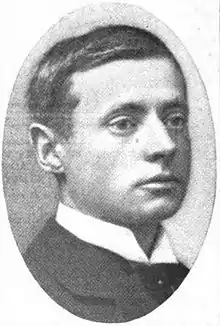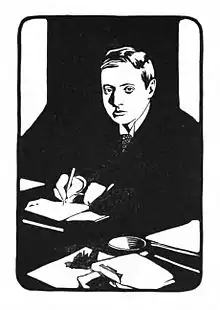W. W. Jacobs
William Wymark Jacobs (8 September 1863 – 1 September 1943) was an English author of short stories and novels.[1] During his career, he was best known for his farcical comedies involving dockside and rural Essex characters. He occasionally wrote horror stories and is best remembered today for "The Monkey's Paw" (1902).
W. W. Jacobs | |
|---|---|
 Portrait of Jacobs by Elliott & Fry | |
| Born | William Wymark Jacobs 8 September 1863 Wapping, London, England |
| Died | 1 September 1943 (aged 79) Islington, London, England |
| Occupation | Short story writer, novelist |
| Nationality | English |
| Period | 1885–1943 |
Early life
Jacobs was born on 8 September 1863 in Wapping, London, where he grew up. His father was a wharf manager on the South Devon wharf at Lower East Smithfield.[2] He was educated at a private school in London and later at Birkbeck College (then called Birkbeck Literary and Scientific Institution, now part of the University of London).[3] There he met and became friends with William Pett Ridge.
Career
Early work
In 1879, Jacobs began work as a clerk in the civil service, in the Post Office Savings Bank, and by 1885, he had his first short story published. His road to success was relatively slow. Arnold Bennett writing in 1898 was astonished that Jacobs turned down the sum of £500 for six short stories. Jacobs was financially secure enough to be able to leave the post office in 1899.
Literature
Jacobs is now remembered for his macabre tale "The Monkey's Paw" (published 1902 in the collection of short stories The Lady of the Barge)[4] and several other ghost stories, including "The Toll House" (published 1909 in the collection of short stories Sailors' Knots) and "Jerry Bundler" (published 1901 in the collection Light Freights).[4][5] However, the majority of his output was humorous in tone. His favourite subject was marine life: "men who go down to the sea in ships of moderate tonnage" said Punch,[6] reviewing his first collection of stories, Many Cargoes, which achieved great popular success on its publication in 1896. Michael Sadleir said of Jacobs's fiction, "He wrote stories of three kinds: describing the misadventures of sailor-men ashore; celebrating the artful dodger of a slow-witted village; and tales of the macabre".[7]

Many Cargoes was followed by the novel The Skipper's Wooing in 1897, and another collection of short stories, Sea Urchins (1898), set the seal on his popularity. Among his other titles are Captains All, Sailors' Knots, and Night Watches. The title of the last reflects the popularity of perhaps his most enduring character: the night-watchman on the wharf in Wapping, recounting the preposterous adventures of his acquaintances Ginger Dick, Sam Small, and Peter Russet. These three characters, pockets full after a long voyage, would take lodgings together determined to enjoy a long spell ashore, but the crafty inhabitants of dockland London would soon relieve them of their funds, assisted by the sailors' own fecklessness and credulity. Jacobs showed a delicacy of touch in his use of the coarse vernacular of the East End of London, which attracted the respect of such writers as P. G. Wodehouse, who mentions Jacobs in his autobiographical work Bring on the Girls! written with Guy Bolton, published in 1954.
The stories which made up Many Cargoes had varied previous serial publication, while those in Sea Urchins were for the most part published in Jerome K. Jerome's Idler. From October 1898, Jacobs's stories were appearing in the Strand, an arrangement that lasted almost to his death and provided him with financial security.
John Drinkwater described Jacobs' fiction as "in the Dickens tradition".[3]
Dramatic work
Jacobs's short-story output declined somewhat around the time of the First World War. His literary efforts between then and his death were predominantly adaptations of his own short stories for the stage. His first stage work, The Ghost of Jerry Bundler, was performed in London in 1899, revived in 1902 and eventually published in 1908.
He wrote eighteen plays in total, some in collaboration with others.
Personal life
Jacobs married Agnes Eleanor Williams in 1900 at West Ham, Essex. Agnes was later a noted suffragette. The 1901 Census records their living with their first child, a three-month-old daughter, at Kings Place Road, Buckhurst Hill, Essex. Also recorded in the household were his journalist sister Amy, his sister-in-law, Nancy Williams, a cook, and an additional domestic servant. Altogether, the Jacobs had two sons and three daughters.[8]
Jacobs went on to set up home in Loughton, Essex, where he had two houses, the Outlook, in Park Hill, and Feltham House, in Goldings Hill, which has a blue plaque to him. Loughton is the "Claybury" of some of the short stories, and Jacobs's love for the forest scenery in the area features in his "Land Of Cockaigne". Another blue plaque shows Jacobs's central London residence at 15 Gloucester Gate, Regents Park (later occupied by the Prince of Wales's Institute of Architecture).
Jacobs stated that although he had held left-wing opinions in his youth, in his later years his political position was "Conservative and Individualistic".[3]
Jacobs died on 1 September 1943 at Hornsey Lane, Islington, London, at the age of 79.
An obituary in The Times (2 September 1943) described him as "Quiet, gentle and modest, he was not fond of large functions and crowds." Ian Hay said of him: "He invented an entirely new form of humorous narrative. Its outstanding characteristics were compression and understatement."[9]
Bibliography
- Many Cargoes, 1896
- The Skipper's Wooing and The Brown Man's Servant, 1897 (novel and novella)
- More Cargoes, 1897
- Sea Urchins, 1898 (also known as More Cargoes, US)
- A Master of Craft, 1900
- Light Freights, 1901
- The Lady of the Barge, 1902 (contains "The Monkey's Paw")
- Dialstone Lane, 1902
- At Sunwich Port, 1902
- Odd Craft, 1903 (contains "The Money Box")
- Captains All, 1905
- Short Cruises, 1907
- Salthaven, 1908
- Sailors' Knots, 1909 (contains "The Toll House")
- Ship's Company, 1911
- Night Watches, 1914
- The Castaways, 1916
- Deep Waters, 1919
- Sea Whispers, 1926
Film adaptations
- 1922. A Master of Craft
- 1936. Our Relations, a Laurel and Hardy feature film with a "suggested by" credit to Jacobs's "The Money Box"
- 1937. Beauty and the Barge
- 1955. Footsteps in the Fog, from the short story "The Interruption"
- 2013. The Monkey's Paw, and versions in 1915, 1923, 1933 and 1948
References
- The New York Times
- Loughton and District Historical Society Newsletter, No. 186. September/October 2010, p. 6.
- "Jacobs, William", in Stanley J. Kunitz and Howard Haycraft, Twentieth Century Authors, A Biographical Dictionary of Modern Literature, (Third Edition). New York, The H. W. Wilson Company, 1950, pp. 721–723.
- Norman Donaldson, "W. W. Jacobs", in E. F. Bleiler, ed. Supernatural Fiction Writers. New York: Scribner's, 1985, pp.383–388. ISBN 0684178087
- Mike Ashley, Who's Who in Horror and Fantasy Fiction. Elm Tree Books, 1977, ISBN 0-241-89528-6, p. 102.
- Punch, vol. 112 p. 54, January 30 1897
- John Sutherland, The Stanford Companion to Victorian Fiction. Stanford University Press, 1990. ISBN 0804718423, pp. 324–325.
- Michael Sadleir "Jacobs, William Wymark (1863–1943)", rev. Sayoni Basu, Oxford Dictionary of National Biography (Oxford, UK: OUP, 2004 Retrieved 13 October 2016.
- Sandra Kemp, Charlotte Mitchell and David Trotter, eds., "Jacobs, W. W.", The Oxford Companion to Edwardian Fiction, Oxford: OUP, 1997, ISBN 9780191727382
External links
| Wikisource has original works written by or about: W. W. Jacobs |
| Wikimedia Commons has media related to W. W. Jacobs. |
- Works by W. W. Jacobs at Project Gutenberg
- Works by or about W. W. Jacobs at Internet Archive
- Works by W. W. Jacobs at LibriVox (public domain audiobooks)

- Works by W. W. Jacobs, at Hathi Trust
- The Monkey's Paw can be read online at American Literature
- The Toll House" Full text.
- W. W. Jacobs at IMDb
- Finding aid to William Wymark Jacobs letters at Columbia University. Rare Book & Manuscript Library.